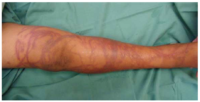ACEM SAQ Sample Questions x5
Download Question Only File Here and give yourself 33 mins to complete to time!
Click here for Answers and see how you went!
Question 1 (16 marks available)
A 55 year old man is brought to the emergency department after taking an overdose of a number of medications. He has a background of hypertension, type II diabetes mellitus, and gout.
- List six (6) of the strongest risk factors for completed suicide in a patient who is considered at risk. (6 marks)
- List three (3) investigations you would order to assess for medication toxicity in a patient with altered mental state, when the substance(s) ingested are unknown. Include an explanation of how each investigation will aid assessment. (6 marks)
iii. On completion of medical and psychiatric assessment, the patient is deemed safe for discharge. State four (4) criteria that suggest this patient is safe to be discharged home. (4 marks)
Question 2 (13 marks)
You are the duty consultant in a northern Australian emergency department during the summer months. You receive a 35 year old female surfer who has been dragged from the water and brought in by car. She is extremely distressed by leg pain.
Vital signs are:
HR 140 bpm (regular)
BP 150/90 mmHg
RR 30 /min
SaO2 90 % in room air
GCS 15
A photo of her right leg is shown.
(Click to enlarge)
- Regarding the diagnosis
- State the MOST IMPORTANT finding in this photo. (1 mark)
- What is the most likely diagnosis? (1 mark)
- If this patient had systemic envenomation as a complication of the most likely diagnosis, list three (3) possible abnormal findings on cardiovascular examination. (3 marks)
- List the two (2) MOST LIKELY causes of her hypoxia based on this scenario. (2 marks)
- Regarding her treatment
- State two (2) specific initial treatments of her leg (apart from analgesia). (2 marks)
- State four (4) clinical indications for the use of anti-venom. (4 marks)
Question 3 (15 marks)
A 48 year old man self presents to your urban district emergency department. There is no on-site interventional cardiology service at your hospital. However, there is a hospital 90 minutes’ drive away with those services. He is complaining of severe, heavy, central chest pain with sweating and shortness of breath. The pain has been present for one hour and is causing him distress. The man weighs 80kg.
Initial vital signs are:
BP 95/55 mmHg
HR 125/min Regular
SaO2 92 % on 6Lpm via Hudson mask
His ECG on arrival is below.
(Click to Enlarge)
- Based on this ECG and the clinical information:
- State three (3) abnormalities on this ECG (3 marks).
- State two (2) conclusions based on the ECG and the patient information given (2 marks).
- Complete the table below by giving four (4) drugs (apart from oxygen) that this patient should be given within the first half hour after his arrival. For each drug state further details regarding their dose and route. (8 marks)
| Drug Name (4 marks) | Further Details (dose and route) (4 marks) |
Question 4 (12 marks)
A 34 year old, G7P6, 38/40 pregnant woman delivers her baby in your resuscitation room. The baby is flaccid and not breathing.
- List the five (5) determinant components of the Apgar score (5 marks)
- Regarding performing neonatal resuscitation in this baby:
- List three (3) immediate actions you would perform. (3 marks)
- State four (4) IMPORTANT differences between newborn and adult resuscitation. (4 marks)
Question 5 (13 marks)
A 38 year old unkempt, clammy and tremulous man presents to the triage desk. He is agitated, shouting and uncooperative with simple instructions. He appears to have needle track marks on his arms.
- Using the categories provided in the table below, list nine (9) differential diagnoses for this man’s presentation. Give a minimum of one (1) and maximum of three (3) diagnoses for each category. Your total list must include the three (3) MOST LIKELY in this patient. (9 marks)
| CATEGORY | DIAGNOSES (9 marks) |
| Systemic disorder eg endocrine, metabolic, generalised infection.
|
|
| Neurological | |
| Drug Related | |
| Psychiatric |
- When assessing this patient’s decision-making capacity.
State four (4) elements that MUST be present to determine that he has capacity to consent to, or refuse, treatment. (4 marks)

